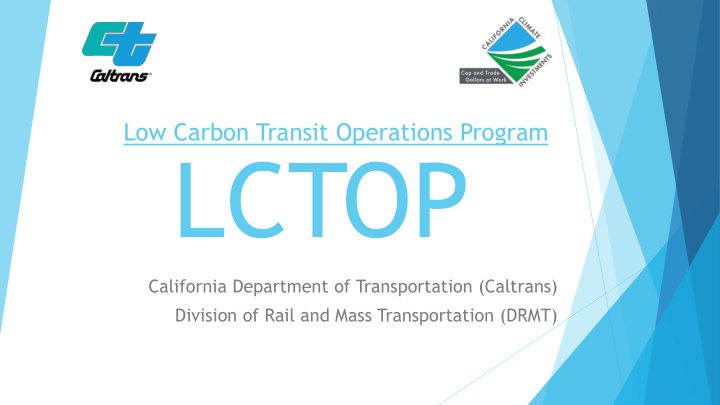



Low Carbon Transit Operations Program LCTOP California Department of Transportation (Caltrans) Division of Rail and Mass Transportation (DRMT)
LCTOP Background LCTOP is a formula based Non-Competitive Program with an annual Appropriations of 5% of the Green House Gas Reduction Fund. Provides Operating and Capital assistance to transit agencies with the goal of reducing greenhouse gas emissions and improving mobility; with an emphasis on serving Disadvantaged Communities (DAC); and meets any of the following: Expenditures that directly enhance or expand transit service by 1. supporting new or expanded bus or rail services, new or expanded water borne transit or expanded intermodal transit facilities, and may include equipment acquisition, fueling, maintenance and other costs to operate those services or facilities. Operational expenditures that increase transit mode share. 2. Expenditures related to the purchase of zero-emission buses, 3. including electric buses, and the installation of the necessary equipment and infrastructure to operate and support zero- emission buses.
LCTOP Eligibility Eligible recipients are entities included in the list provided by the State Controller’s Office (SCO). Entities are transportation planning agencies and/or transit operators that are eligible for State Transit Assistance Fund (STA) per PUC 99313 or 99314. Transi t fare revenue Transit Agenc collected by Agency y agency %Allocated fare revenue Transit collected in all of Agency California 50% Regional Regional Entity population 50% % Allocated Statewide Regional population Entity
LCTOP FY14-15-FY18-19: 685 Awarded projects totaling $377.2m Operating Capital Transit Pass Reduction ZEB Procurement Free Summer Passes Electric Hydrogen National Park Transit Service ZEV Procurement Commuter Express Service Electric Charging Stations Expanded Night and Weekend Service Electric Charging Infrastructure at transit facilities Solar Panel for lights and charging
LCTOP FY14-15-FY18-19: ZEV/ZEB +Supporting Infrastructure: $91,465,248 Funding By Year Funds by Project Type Infrastructure to support zero-emission vehicle(s) $90,000,000 New zero-emission $20,000,000 vehicles $80,000,000 $18,000,000 Renewable energy/fuel for transit service $16,000,000 $70,000,000 $14,000,000 $60,000,000 $12,000,000 $50,000,000 $10,000,000 $8,000,000 $40,000,000 $6,000,000 $30,000,000 $4,000,000 $20,000,000 $2,000,000 $0 $10,000,000 1 2 3 4 5 6 7 8 9 11 12 $0 14-15 15-16 16-17 17-18 18-19 Total
LCTOP Allocation Request LCTOP FY 19-20 Estimated Apportionment of $140-150M LCTOP Allocation Apportionment announcement: TBD Late January 2020 Allocation Request Due Date: March 2020 + + Upcoming Workshops: DRAFT Guidelines Workshops-TBD November 2019 Allocation Request Workshops-TBD January-March 2020
LCTOP Contact Information
Transit and Intercity Rail Capital Program TIRCP California State Transportation Agency (CalSTA) California Department of Transportation (Caltrans) Division of Rail and Mass Transportation (DRMT)
TIRCP Background $2.65 Billion of FY18-19 through FY22-23 of SB1 and GGRF $1.150 Billion of Additional Multi-Year Funding Agreement Funding Over the last three cycles, $5.3 Billion in funding has gone to 50+ projects throughout the State The projects are located within and providing direct, meaningful and assured benefits to disadvantaged communities, low-income communities and low-income households.
TIRCP Background Recipient Agencies of Past Awards: Railcars/Locomotives: Metrolink; Caltrain; SF Muni; LOSSAN; ACE; SMART; San Diego MTS Rail Infrastructure: BART to San Jose; ACE to Merced; LA Metro Red, Purple, & Blue Lines; LOSSAN/Coaster, Capitol Corridor, Sacramento & OC Streetcars; Redlands Rail Zero-emission and other bus projects: Stockton; Fresno; Monterey-Salinas; Antelope Valley; San Diego; Orange County; Coachella Valley
TIRCP – Statutory Requirements Competitive 5-year program to fund a small number of transformative projects that improve the statewide network and reduce greenhouse gas emissions. Primary evaluation criteria: emission reduction, ridership growth, achievement of integrated service, and safety benefit. Secondary evaluation criteria: co-benefits of broader sustainable community goals, disadvantaged community benefits, geographic balance, network integration, housing and job considerations. 11
TIRCP 2020-21 through 2024-25 Funding Senate Bill 1 directs loan repayments and a portion of the new Transportation Improvement Fee to the TIRCP An estimated $439 million will be available over the 2020-21 to 2024-25 period The fund estimate, award amount and adopted program for TIRCP is based on anticipated revenue through 2024-25 and will be included in the call for projects made once final guidelines are released Implementation of an allocation plan is conditioned upon funding availability, and the plan may be adjusted once adopted to address project needs as well as funding availability 12
TIRCP - Key Changes to the Guidelines Network Integration Housing and Job Consideration Project Implementation and Reporting 13
2020 TIRCP Cycle 4 Timeline Release Final Draft Guidelines on Sep. 13 th & Guideline Workshops: Oct. 14th: Los Angeles Oct. 15th: Oakland Guidelines adoption/call for projects: Oct. 18 th Applications due: Jan.16 th , 2020 CalSTA announces project awards: Apr.1 st , 2020 Optional Consultation Meetings: Nov. 4 th : Sacramento 11am-5pm Nov. 7 : Oakland th 9am-5pm Nov. 5 th : Los Angeles 10am-5pm Nov. 8 th : Stockton 8am-12pm Nov 12: Northern CA limited time Nov. 6 th : Los Angeles 8am-3pm 14
Questions and Feedback Information for TIRCP: websites: www.dot.ca.gov/drmt/sptircp.html and www.calsta.ca.gov Guideline comments email: tircpcomments@dot.ca.gov Questions: Chad Edison at 916-323-5400 15